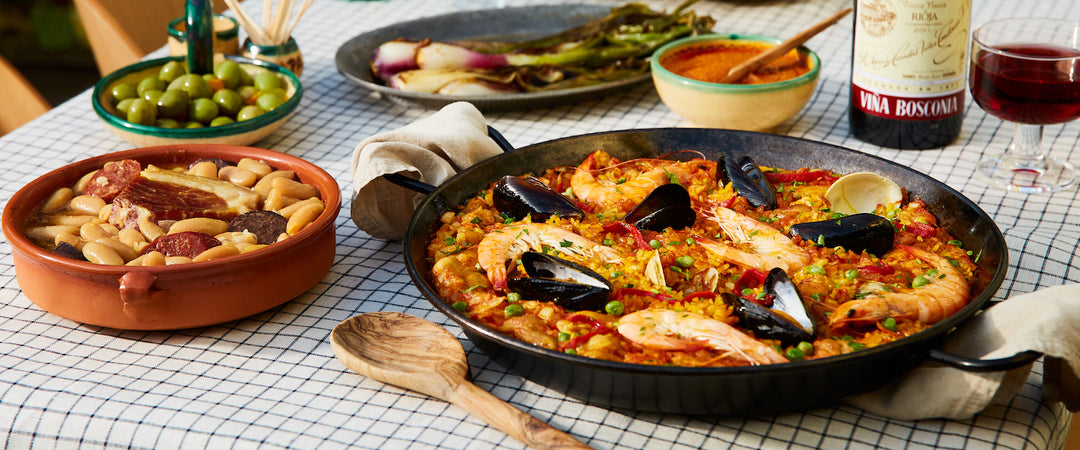October 2025 Blanco Y Tinto Club
 |
Condes de Valdemar Regular Price: $26.99
Club Price: $22.94
|
We should all be drinking more white wine from Rioja. Full stop. While it only makes up ~9% of total wine production, it remains a diverse and continuously evolving genre in the pantheon of Spanish wine. “But Tempranillo Blanco?” you might ask, “I thought Rioja Blanco had to be Viura? And if it’s so great, why only 9%?” These are fair inquiries, but it is a long way to the top from your grandmother’s oxidative, stinky aperitif, so refer to the first sentence of this blog post if you need a TL;DR.
A fascinating and frustrating aspect of Spanish wine legalities, in addition to viticultural and enological production standards, is the resultant wine must organoleptically resemble the typical wines of its home region. Meaning, a wine from Rioja must smell and taste like a ‘typical’ wine of Rioja. This means every label a winery produces must be tasted by a panel of independent judges before it can receive its D.O. classification. For a youthful white from Rioja this means a wine must present by the following:
-
Eye: Straw-yellow with a lemon green rim; clean and bright.
-
Nose: Green fruit, floral and vegetable aromas, typical of the variety.
-
Mouth: Moderate acidity with a sensation of freshness.
Additionally, only the following grapes may be used: Viura, Garnacha Blanca, Malvasía, Maturana Blanca, Tempranillo Blanco, Turruntés, Chardonnay, Sauvignon Blanc and Verdejo. You can begin to see where some conflict/ambiguity may arise here. Many of the above grapes have very different personalities which sets up some for success (Viura) and others for failure. Coming full circle, Condes de Valdemar is actually credited as one of the early promoters for Viura in the late 1800s. The ‘traditional’ way to vinify this grape was to allow some or complete oxidation, or intentionally exposing the aging wine to open air while vinifying. This is best expressed by Lopez de Heredia’s Gravonia (if you can find it), which boasts desiccated orchard fruit, cheese rind, and potpourri notes. Don’t misunderstand us, the aforementioned wine is delicious, but stylistically grates against the average American palate. If we had to speculate why Viura is not more popular, this traditional style of Rioja blanco would be among the reasons.
This month’s white selection is stylistically at the opposite end. It’s crisp, bright, and mineral-driven. It’s also Tempranillo Blanco, the white mutation of Tempranillo Tinto. They share a familial relationship, similar to Pinot Noir and Pinot Gris, if that helps paint a picture. It’s a wonderful fresh take on the Rioja blanco genre from an up and coming grape that deserves much more attention.
Pale yellow in color, the wine has fresh pear and honeydew aromas. Hints of a swath of citrus and a touch of herbs rounds out the nose. The taste confirms the nose, and the texture of wine is broad and round. The finish is accented by some minerals and salinity, reminiscent of the limestone soils of the Cantabrian mountain range by which the grapes are from. Enjoy with light white fish dishes, or hearty earthy vegetable dishes such as lentil stew!
 
|
Vinedos de Norrel Robertson Regular Price: $46.99
Club Price: $39.94
|
If Charlotte Allen’s La Píríta (our April 2025 ByT red) told the story of an Englishwoman mastering the native grapes of Arribes (Juan García, Rufete, and Bruñal) then Norrel Robertson’s “Manda Huevos” is its spiritual cousin from Aragón. Like Charlotte, Norrel is an expat who chose Spain, learned its soils, and earned the respect of its winemakers not by imitation but by immersion. A Master of Wine from Scotland, Norrel moved to Calatayud in 2003, drawn by the haunting beauty of its crumbling villages and its ancient Garnacha vines clinging to rocky hillsides. The Spanish call him El Escocés Volante—“The Flying Scotsman”—a nickname that sticks because his career has spanned continents, yet his wines are firmly rooted in place.
Norrel’s work revolves around single vineyards, each a self-contained world of exposure, soil, and vine age. “Manda Huevos” comes from Caña Andrea, two adjoining parcels near Villarroya de la Sierra, one planted in 1908, the other in 1970, and both at elevations around 750 meters. The older plot is a true field blend, where Garnacha grows side by side with Moristel, Bobal, and even Garnacha Blanca, a mix that adds depth and subtle aromatic lift to the wine’s red fruit core. The soils are red clay and limestone studded with pudding stones, a landscape that forces vines to struggle, yielding small clusters of concentrated berries with remarkable balance between ripeness and acidity.
For the 2019 vintage, Norrel embraced a light hand in the cellar: 20% whole clusters, spontaneous fermentation in open-top vats, and aging primarily in Flextank eggs, which maintain purity of fruit without imparting oak flavor. A single neutral 500-liter barrel rounded out the blend, and only 3,731 bottles were produced. The result is a wine of paradox: ripe yet restrained, structured yet ethereal, carrying that signature mountain freshness that defines the best high-altitude Garnacha. It’s a wine that mirrors Norrel’s intellectual precision and his belief that restraint is the truest path to expression.
Norrel’s reputation today extends far beyond this label. Some of his top single-vineyard bottlings fetch prices north of $100, revered by collectors for their finesse and longevity. Yet “Manda Huevos,” with its sly name (anyone wanna guess?) and humble origins, captures the beating heart of his philosophy: wines of character, made from places that deserve to be known by name. Each vineyard, he says, is a story waiting to be told—and this one speaks of red dust, century-old roots, and a foreigner who made Aragón his home.
Like Charlotte’s wines from Arribes, “Manda Huevos” reminds us that Spain’s most exciting winemaking often comes from outsiders who’ve learned to listen deeply to the land. It’s Garnacha reimagined—not the heavy, jammy stereotype, but a perfumed, lifted, chalky expression that feels closer to fine Pinot Noir than to rustic country red. In the glass, it’s a dialogue between old vines and new eyes—a Scotsman’s reverent love letter to Spanish soil. And in a sky of native born superstars with names like Raul Perez and Alvaro Palacios, it's nice to see an immigrant star shine.
It's a wine that I feel needs a moment of focus. Enjoy it's blend of austerity and giving. But do drink it in one sitting. Of all the wines we've had of late, it was not one of the wines that develops further with time in open bottle. I would enjoy it as a sipper over a good book or pair it with very light red sauces or maybe even a cioppino style seafood stew.



